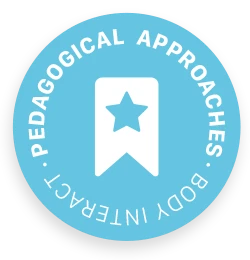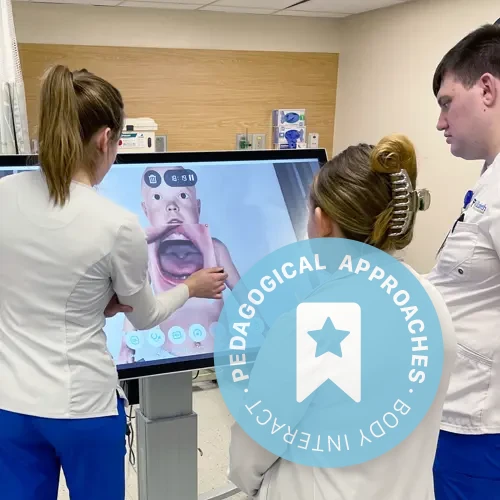
What is Peer Assisted Learning?
Peer Assisted Learning (PAL) is a collaborative educational approach in which students help each other learn by teaching their peers. In this model, students assume the role of teachers, explaining concepts, answering questions, and guiding their classmates through learning materials and pedagogical experiences. This method leverages the natural social interactions among learners, allowing for a more interactive and engaging learning experience.
Key aspects of peer teaching include:
- Student-Centered: It shifts the focus from a traditional teacher-led classroom to a more student-centered environment, where learners take responsibility for both their learning and that of their peers.
- Mutual Benefit: Peer teaching benefits both the teacher and the learner. The peer-teacher reinforces their understanding of the material by teaching it, while the peer-learner gains insight from a different perspective.
- Confidence and Communication Skills: Peer teaching can enhance communication skills and build confidence, as students practice explaining complex ideas clearly and answering questions.
- Diverse Perspectives: Students often explain concepts in ways that are relatable to their peers, offering fresh insights and relatable examples.
- Collaborative Learning: Peer teaching encourages teamwork and collaboration, fostering a supportive learning community.
There are also different levels of PAL, according to the age and experience level gap between peers: Near peer teaching, Cross-Age Peer teaching, Collaborative Peer Teaching, Tandem teaching, or Expert Peer Teaching.

How can it be applied with Body Interact?
PAL with virtual patients can be an innovative and effective pedagogical approach, particularly in medical and nursing education. Here’s how it can be applied:
- Group-Based Learning: In a peer teaching setting, students can work together in groups, navigating the virtual patient scenarios on Body Interact. One student can take the lead, guiding the team through the case, making decisions, and explaining their reasoning. Other students can ask questions, offer alternative suggestions, and contribute to the discussion.
- Role Rotation: To ensure everyone benefits, roles can be rotated. Students can take turns being the primary decision-maker, challenger, or note-taker, allowing them to experience different aspects of the learning process.
- Feedback and Reflection: After working through a case, the group can engage in a reflective discussion. They can analyze what went well, where improvements could be made, and how their decisions aligned with real-world clinical practice. This reflection can also be guided by faculty or more experienced students, providing an additional layer of feedback.
- Synchronous or Asynchronous Learning: Peer teaching with virtual patients can happen in real-time or asynchronously. In a synchronous setting, groups can collaborate in face-to-face interaction or via video conferencing.
In an asynchronous model, students can work independently in a case, and then share their findings and reflections in a face-to-face session, through discussion boards or recorded videos. - Cross-Level Learning: This pedagogical approach can also enable students at different stages of their education to collaborate. More advanced students can guide less experienced peers through complex cases, offering mentorship and sharing practical insights.
- Expanding Accessibility: Virtual patients make case-based learning more accessible, regardless of geographical location. This means peer teaching can transcend traditional classroom boundaries, allowing students from different institutions or regions to collaborate.

In summary, peer teaching with virtual patients offers a dynamic and interactive approach to medical education, combining the benefits of technology with collaborative, student-led learning. This approach enhances students’ clinical skills, decision-making abilities, and communication skills, preparing them for real-world medical practice.
What are the benefits of using Peer teaching and combining it with Body Interact Virtual Patients?
Peer teaching offers a range of benefits for students, faculty, and higher education institutions, enhancing both the educational experience and operational efficiencies.
Benefits of the Peer teaching for peer-student:
- Learning Environment: Provides a comfortable and open environment.
- Enhanced Student Engagement and Learning Outcomes: Peer teaching can lead to better retention of material and higher performance on assessments, as students learn in a more interactive and collaborative environment.
- Enhanced Community and Collaboration: Instituting peer teaching programs fosters a stronger sense of community and collaboration among students, which can improve the overall campus climate and student satisfaction.t.
Benefits of Peer teaching for peer-teacher:
- Knowledge Consolidation: Provides an opportunity for revision and furthering knowledge. It can be observed increased engagement as students who teach their peers often delve deeper into the subject matter, ensuring they understand it well enough to explain it to others.
- Communication Skills Development: Finding strategies to clarify complex ideas to colleagues enhances communication abilities, crucial for collaboration within teams and when interacting with patients.
- Development of Critical Skills: Not only communication skills are developed but also critical thinking, leadership, and problem-solving, which are essential for their future careers.
Benefits of the Peer teaching for faculty and higher education institutions:
- Cost-Effective Method: Professors and organizations benefit from implementing student-led teaching, as it allows for the delegation of responsibility, more efficient resource allocation, and, ultimately, contributes to the development of a sustainable healthcare system of providing an adequate education.
- Increased Instructional Resources: PAL effectively expands the teaching resources of an institution without additional cost. Students supplement faculty efforts by helping each other learn, which can be particularly beneficial in large classes or under-resourced departments.
- Curriculum Innovation and Flexibility: Peer teaching encourages the adoption of innovative teaching methods and tools. This can lead to a more dynamic curriculum that better meets the diverse needs of students. It allows for more flexible learning structures, such as flipped classrooms and blended learning environments, where faculty can focus on more complex teaching tasks while peers handle foundational training.
- Improved Faculty Efficiency: By delegating some instructional responsibilities to student peers, faculty can manage their time more effectively, focusing on curriculum development, research, and personalized student support. This can lead to improved job satisfaction, alleviate teacher load, and reduce burnout among faculty members.
- Scalability of Teaching Efforts: This pedagogical approach is scalable and can be integrated into various courses and programs with minimal additional resources, allowing institutions to support larger student bodies effectively.
- Research and Innovation Opportunities: Faculty can engage in research on peer teaching methodologies, assessing their effectiveness and exploring improvements. This research can contribute to the educational field and elevate the institution’s standing in academic communities. Innovation in teaching methods can attract grants, partnerships, and other opportunities for the institution.
In summary, peer teaching not only enriches the student learning experience but also offers significant strategic benefits for faculty and institutions, making it a valuable component of modern higher education.
Peer teaching best practices suggestions:
- Peer-Led Medical Curricula: Peer teaching should be embedded in the formal curriculum so that both parties recognize its value. Use peer teaching as a complement to traditional classroom instruction, integrating it into a blended or flipped classroom model for enhanced learning.
- Group Size: Small groups usually promote more effective learning and engaging environments.
- Definition of Roles and Objectives: Establish clear goals for the peer teaching session. Outline what topics will be covered, what skills will be developed, and how success will be measured. Assign specific roles to peer teachers, such as topic introducer, explainer, or moderator, to ensure smooth collaboration.
- Training and Preparation: Provide training for peer teachers on effective teaching techniques, such as how to explain concepts clearly, manage group dynamics, and provide constructive feedback. Ensure that peer teachers thoroughly understand the material they will cover, equipping them with resources.
- Foster an Inclusive Environment: Encourage a supportive atmosphere where students feel comfortable sharing ideas, asking questions, and learning from one another. Promote active listening and respectful dialogue within peer teaching sessions to ensure all voices are heard.
- Encourage Collaboration and Feedback: Design peer teaching sessions to be collaborative, allowing students to work together to solve problems, share insights, and reflect on learning outcomes. Provide opportunities for peer teachers to give and receive feedback, both within their groups and from faculty, to refine their teaching skills.
- Leverage Technology: Utilize technology tools, such as virtual meeting platforms, learning management systems, and online discussion boards, to facilitate peer teaching sessions and enable collaboration. Consider incorporating interactive tools, such as quizzes and Virtual Patient simulators, among other types of simulators, to enhance engagement and comprehension.
- Facilitate Reflective Learning: After each peer teaching session, encourage reflective learning by having students analyze what they learned, how they learned it, and how it applies to broader contexts. Reflection can be incorporated into group discussions, written assignments, or one-on-one feedback sessions.
- Monitor and Evaluate: Continuously monitor the effectiveness of peer teaching sessions through surveys, feedback, and performance metrics. Use this data to refine the program and address any areas of concern. Evaluate both the content delivery and group dynamics, ensuring the program meets both educational and interpersonal objectives.
- Recognition and Incentives: Recognize the efforts of peer teachers through certificates, or other incentives to acknowledge their contributions and encourage continued participation. Highlight success stories and outcomes from peer teaching programs, showcasing their impact on the learning community.
Who is using this instructional strategy?
María Fernanda Chaparro / Diego Nara
From the Anáhuac Querétaro University, Professor María Fernanda Chaparro, the Coordinator of the university’s simulation center, and Dr. Diego Nara, Academic Assistant have been successfully employing this strategy in Near-Pear teaching approach with Body Interact Virtual Patients.

Image courtesy of Professor María Fernanda Chaparro and Dr. Diego Nara.
Want to know more about this pedagogical approach?
Schedule a demo with the Body Interact team
References
Herrmann-Werner A, Gramer R, Erschens R, Nikendei C, Wosnik A, Griewatz J, Zipfel S, Junne F. Peer-assisted learning (PAL) in undergraduate medical education: An overview. Z Evid Fortbild Qual Gesundhwes. 2017 Apr;121:74-81. doi: 10.1016/j.zefq.2017.01.001. Epub 2017 Feb 9. PMID: 28545616.
Lu EL, Harris MK, Gao TZ, Good L, Harris DP, Renton D. Near-Peer Teaching in Conjunction with Flipped Classroom to Teach First-Year Medical Students Basic Surgical Skills. Med Sci Educ. 2022 Aug 1;32(5):1015-1022. doi: 10.1007/s40670-022-01602-0. PMID: 35936650; PMCID: PMC9340706.
Malmut L, Ng A. Near-peer teaching in simulation. Clin Teach. 2023 Oct;20(5):e13645. doi: 10.1111/tct.13645. Epub 2023 Aug 26. PMID: 37632300.
Ten Cate, O., & Durning, S. (2007). Peer teaching in medical education: twelve reasons to move from theory to practice. Medical Teacher, 29(6), 591–599. https://doi.org/10.1080/01421590701606799







